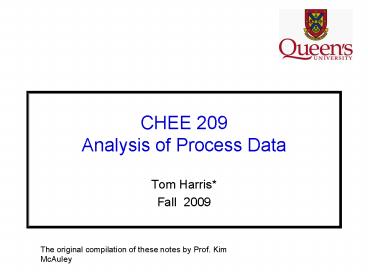CHEE 209 Analysis of Process Data PowerPoint PPT Presentation
1 / 11
Title: CHEE 209 Analysis of Process Data
1
CHEE 209Analysis of Process Data
- Tom Harris
- Fall 2009
The original compilation of these notes by Prof.
Kim McAuley
2
Role of Statistical Methods
- Summarizing data
- using a few key numbers or graphs
- uncover or reveal complex patterns
- Decision-making in the presence of uncertainty
- Has the concentration of a contaminant in an
effluent stream changed appreciably? - Has the quality of our polyurethane foam
improved? - Is the quality of a mineral deposit sufficient
to justify investments? - Use confidence limits and hypothesis tests and
control charts to find answers to these
questions.
3
Role of Statistical Methods
- 3. Identifying relationships in data
- Designing experiments to uncover relationships
among variables, - Fitting empirical models between reactor
temperature and product yield - Development of calibration methods for chemical
property analysis - Test suitability of various models
4
Why do need statistical methods?
- Presence of Process or Inherent Variability
- Price of Platinum
- Temperature Measurements
- Moisture Content of a Paper Product
5
Sources of Process Variability
- instrumentation and measurements
- operator interventions
- disturbances
- from raw materials or upstream units
- Temperature or composition of feed stream
- ambient conditions
- Air temperature
- Cooling water temperature
- external factors demand, speculation
6
Types of Data
- Discrete
- number of defective items, number of people
- colours
- taste
- Continuous
- temperature
- pressure
- composition
Combination discrete continuous
7
Types of Data
- May be collected with respect to time, i.e.
composition measurements every hour, minute or
second - Spatial component
- Collected with respect to distance
- 2 or 3 D
8
Data Collection
- Passive Collection
- record results without actively intervening in
the operation of the process - historical databases of operational or
geophysical data - Active Collection Intervention
- do a planned experiment
- guarantees a cause and effect relationship
- Example police officers and crime
9
Value of statistical methods
- Established body of both theory practice that
provides a scientific systematic approach for - collection of data
- methods for analysis and interpretation
- Used to assist in decision making (statistics
doesnt replace sound engineering judgment and
knowledge) - Universal language that transcends specific
disciplines, i.e. engineering, business, law,
medicine
10
Course Overview
- describing data
- describing variability
- probability
- decision-making in the presence of uncertainty
- hypothesis tests and confidence intervals
- statistical quality control
- empirical modeling
- linear regression
Examples from chemical engineering, chemistry
geosciences
11
Course Objectives
- Understand motivation for use of statistics
- Proficient and confident in using a number of
introductory techniques using hand and
computer-based calculations - Develop a critical awareness regarding
statistical thinking which is important for
your responsibilities as engineers and citizens.

